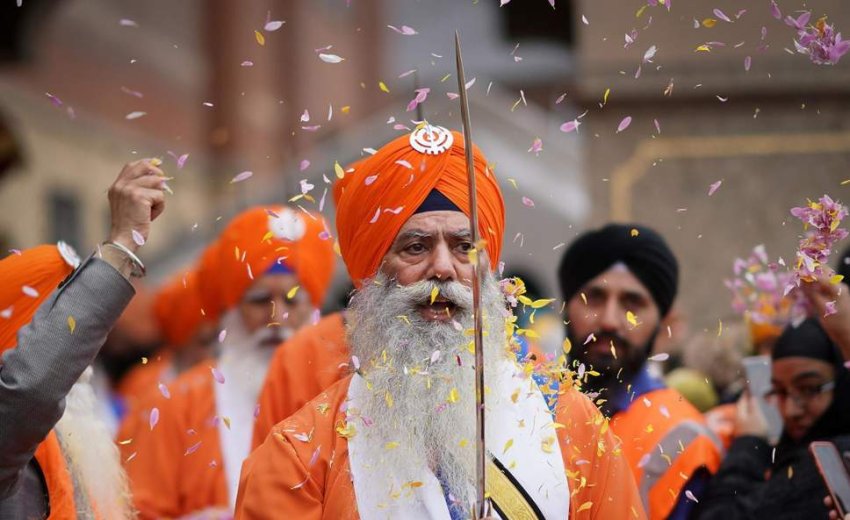Every April, the Sikh community all over the world gathers to celebrate Vaisakhi. For decades, Vaisakhi has marked the beginning of the spring harvest, and Punjabi farmers have observed the occasion with community gatherings and celebrations. Vaisakhi is also known as Baisakhi.
It was originally a spring harvest celebration observed in the northern Indian state of Punjab. The festival gained religious significance for Sikhs when in 1699, the 10th Sikh guru-prophet, the last living guru for Sikhs, Guru Gobind Singh, chose the occasion to found a formal order dedicated to defending the Sikh community, known as the Khalsa Panth.
Sikhs all over the world celebrate the festival of Baisakhi, a holiday with a special religious significance, observed each year on April 13 or 14.
The Story of Vaisakhi
On the Vaisakhi day of 1699 (the first day of the month of ‘Vaisakh’ in the Sikh calendar), Guru Gobind Singh Sahib, the tenth Guru, formalized the concept of Saint-Soldier by introducing the Amrit ceremony (the formal initiation ceremony). He transformed the Sikhs into a family of soldier saints, known as the Khalsa Panth.
The Guru requested the Sikhs to congregate at Anandpur on Vaisakhi. According to the Sikh tradition, he asked for a volunteer who was prepared to give his life for his faith to come into the tent. One came forward, whom he took inside a tent. The Guru returned to the crowd alone, with a bloody sword. He asked for another volunteer and repeated the same process of returning from the tent without anyone and with a bloodied sword four more times. After the fifth volunteer went with him into the tent, there was confusion and unease among the crowds. The Guru returned with all five volunteers, all safe. He called them the Panj Pyare and the first Khalsa in the Sikh tradition.
Each of the initiates was instructed to keep the five K’s: Kes (uncut hair), Kangha (a small comb), Karra (an iron bracelet), Kachera (a white undergarment), and Kirpan (a small curved sword of any size, shape or metal).
The title of Khalsa refers to people whose life and spirit are solely the property of the One Universal Creator and not of any king, dictator, or even a messenger of the Creator. The Sikh faith was founded on the idea that there is only one Universal Creator and that all people are therefore equal, regardless of their religion, gender, ethnicity, color, caste, or other attributes.
A collective name given to the first five Khalsa is Panj Pyare. The Panj Pyare who were baptized by Guru Gobind Singh Ji were -Bhai Daya Singh, Bhai Dharam Singh, Bhai Himmat Singh, Bhai Mohkam Singh, and Bhai Sahib Singh.
All five of the men were then seen emerging with the Guru, each wearing an orange suit and bib. These colors are symbols of Sikhism. In a novel and distinctive ceremony known as pahul, which Sikhs now refer to as the baptism ceremony known as Amrit, he baptized the five. Then the Guru asked those five baptized Sikhs to baptize him as well. This is how he became known as Guru Chela both teacher and student. Then he proclaimed that the Panj Pyare, also known as the Five Beloved Ones, would embody the Guru himself: "Where there are Panj Pyare, there am I. When the Five meet, they are the holiest of the holy." Thus with these principles, he established Panth Khalsa, the Order of the Pure Ones.
How is the festival of VAISAKHI celebrated?
Vaisakhi celebrations begin at the gurdwara, a place of worship for Sikhs. All gurdwaras are beautifully decorated where the religious services take place. Many people enjoy parades and special processions through the streets called “Nagar kirtans”. 'Nagar' means town, and 'kirtan' means singing hymns from the Guru Granth Sahib, the Sikh holy book. The Guru Granth Sahib is carried in a place of honor throughout processions. Celebrations traditionally also include the reading of scriptures out loud and chanting of hymns.
During the Baisakhi processions, children and youth demonstrate their skills in martial arts to the accompaniment of musical bands, making the event more colorful.
Food is also served for free, this is known as ‘Langar’ which is part of the Sikh culture. Langar serves as a powerful way to socialize and connect with others who join.
Yellow and orange are the traditional colors of Vaisakhi. They reflect the spirit of rebirth and sacrifice of the Punj Pyare, but they are also a color of joy and festivities. When Vaisakhi is celebrated in Punjab, the bright yellow wheat fields are ready for harvest.
The Punjabi farmers thank God, on the special occasion of Vaisakhi, for a plentiful harvest and pray for a good one in the coming year. Many Sikhs choose the day of Vaisakhi to be baptized into Khalsa.
A large celebration is held in Anandpur Sahib, the city where Guru Gobind Singh founded the Khalsa order.
Vaisakhi, which celebrates the Sikh spirit, highlights the blending of the spiritual and temporal worlds and provides valuable ways to do so through a common set of beliefs and customs. Countries beyond the Indian subcontinent with significant Sikh populations hold notable public celebrations by coming together with their local communities at gurdwaras to pray and meditate on principles advocated by Sikhism. It is a day for Sikhs to renew and rekindle loyalty to the Guru and their faith.
